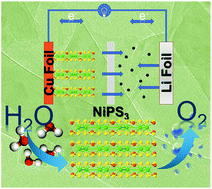Few-layer NiPS3 nanosheets as bifunctional materials for Li-ion storage and oxygen evolution reaction†
Abstract
The construction of two-dimensional (2D) ultrathin nanosheets is considered as a promising strategy for enhancing electrochemical performance, owing to their large surface area and fast electron transport. In this study, ultrathin few-layer NiPS3 nanosheets are obtained and systematically investigated by high-yield liquid phase exfoliation from their bulk layered crystals, and are exploited as anodes for lithium ion batteries (LIBs) and electrocatalysts for oxygen evolution reaction (OER). When evaluated as an anode for LIBs, NiPS3 nanosheets show excellent electrochemical properties in terms of stable cycling performance and rate capabilities. A stable reversible capacity of 796.2 mA h g−1 is delivered after the 150th cycle at a current density of 100 mA g−1. As for the OER, the exfoliated few-layer NiPS3 nanosheets have demonstrated excellent electrocatalytic performance, such as a low overpotential of 301 mV at a current density of 10 mA cm−2, a small Tafel slope of 43 mV dec−1, and an outstanding long-term durability. This work is expected to make a contribution to develop next generation high-performance electrochemically active materials for catalysts and batteries.



 Please wait while we load your content...
Please wait while we load your content...